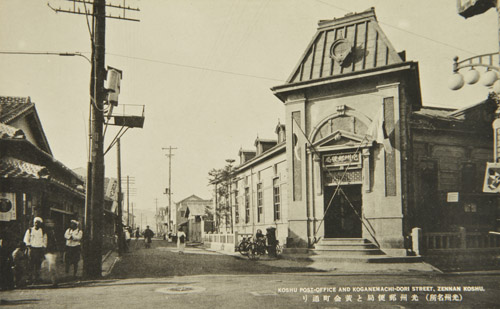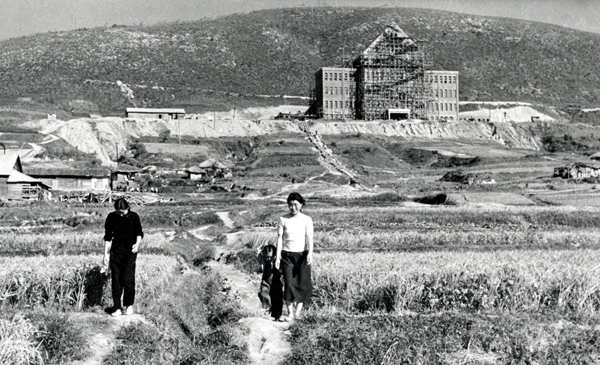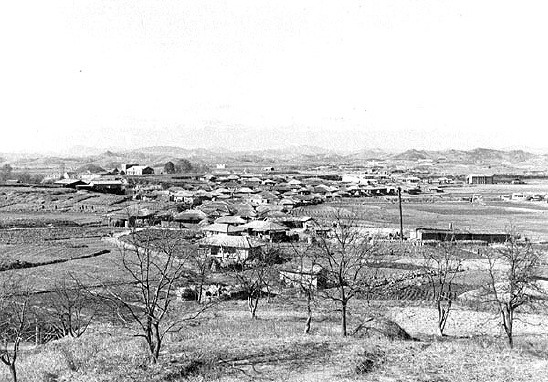Gwangju in History
When we think of the history of Gwangju, our thoughts flow back four decades to the May 1980 Uprising, but that event was like yesterday in the long span of Gwangju’s bygone days. To bring us more up to date on the city’s past, An Se-in (in cooperation with Hong Chang-woo) originally contributed “The History of Gwangju” to the March 2014 issue of the Gwangju News. We are again running the article here, revised with several updates. — Ed.
What is Gwangju? The answer is not as simple as the question. Gwangju has been called the city of Uihyang (의향), Yehyang (예향), and Mihyang (미향). From the time of the Japanese invasions in the Imjin War (1592–1598) to the May 18 Democratic Movement (1980), Gwangju has taken pride in being a “righteous” city (Uihyang), growing as a city internationally renowned for its commitment to human rights. As a city of the arts (Yehyang), Gwangju is the home of artists such as Im Bang-ul, a master singer of pansori, and Oriental painter Heo Baek-ryeon. Gwangju is also the host city of the Gwangju Biennale, which has been drawing attention from contemporary artists around the world. Finally, Gwangju is well known for its delicious cuisine (Mihyang), and not least for its annual World Kimchi Culture Festival.

Gwangju predates recorded history in that human artifacts from the Stone Age, as well as from the Bronze Age and the Iron Age, have been discovered in the region. Many examples of “jar burial,” interment in a unique jar-shaped earthenware coffin, have also been discovered in the Gwangju and Yeongsan River area.
The Samhan states of Mahan, Jinhan, and Byeonhan (1st century B.C. to 3rd century A.D.) eventually developed in the southern half of the Korean Peninsula. Of these three states, Mahan was in the southwestern part of the peninsula. It was at this time that the Gwangju area developed into the mini-state of Gusao-danguk (구사오단국). Following this period, the three ancient kingdoms of Goguryeo, Baekje, and Silla were established, and the Gwangju area came under the control of the Baekje Kingdom (18–660 A.D.). At the time, the administrative area that the Gwangju area was part of was known as the Mujinju (무진주) district of Baekje.

In 660 A.D., Silla joined forces with Tang China and unified the three kingdoms as Unified Silla. In Unified Silla, the district remained as Mujinju for a while, but eventually its name changed to Muju. At the end of United Silla, many new powers rose up and began the Later Three Kingdoms Period, a fragmented period with less central control. In 892, Kyeon Hyeon established posts in Later Baekje, based in the Jeolla areas of Jeonju and Muju and called himself “king.”
The Later Three Kingdoms were finally reunified by Goryeo in 936. During the Goryeo Dynasty, the name “Gwangju” began to be used for the first time in 940. The South Jeolla area was known as Jasa, and within it were three administrative districts that were of the rank of “ju” (주/州): Damju (present-day Damyang), Paeju (present-day Boseong), and Gwangju. Redistricting of administrative units was frequent, as was the status of population centers. By the end of the Goryeo period, Gwangju was known as “Mujin-bu.”

In the 13th century, the Mongol Empire invaded Goryeo. At the time, Goryeo’s government was dominated by military officials called musin. Because of the endless war and the musin’s exploitation of the people, many revolts occurred across the country. In the Gwangju area, Lee Yeon-nyeon rebelled against the harsh treatment his people were receiving (1237). Goryeo continuously stood against the Mongols. The Sambyeolcho, the special military unit of the musin government, continuously fought against the Mongolian forces (1270–1273). After defeat at Ganghwa Island, the Sambyeolcho moved to Jindo Island, just off the southwest coast, and held influence over the Gwangju area.
After the establishment of the Joseon Dynasty in 1392, the name of “Gwangju” continued to be used, but just as in the Goryeo period, it frequently changed. The Gwangju area eventually became part of the Gwangju-hyeon administrative unit, from which Gwangju-mok later became independent in 1634. Since Gwangju rests on a large plain and was located at a traffic juncture, it was rich in agricultural products, and trading was brisk.

Through the Joseon Dynasty era, Gwangju became known as a town of loyal troops and Confucian scholars known as salim. New groups of Confucian scholars influenced the progress of Neo-Confucianism in the Honam region. Heated debate between Lee Hwang and Ki Dae-seung, particularly over explanations for the Neo-Confucian idea of sadan-chiljeong (사단칠정, the term referring to the four aspects of human nature and the seven emotions) had an important influence on Confucian ideas. As a Gwangju scholar, Ki Dae-seung put emphasis on practice over theory. This period was the peak of Neo-Confucianism and literature in Gwangju.
During the Imjin War, Ko Gyeong-myeong and Kim Deok-ryeong led loyal troops from the Gwangju region and played an important role in the war. South Jeolla’s coastal region was also where Admiral Yi Sun-shin famously defeated the much larger Japanese navy.

In 1894, the Donghak (동학, Eastern Learning) Peasant Movement occurred in Jeolla as a response to imperialist countries coercing Joseon to open its ports to trade. Son Hwa-jung was one of three key figures of the Donghak Uprising in Gwangju. Even though the rebellion against Japanese influence and the feudal system ended in failure, it was an important historical event.
Gwangju was designated as the capital of the newly formed South Jeolla Province in 1896. Thereafter most public institutions were moved from the former capital of Naju to Gwangju. As an aside, that Naju (羅州) and Jeonju (全州) were once the two main population areas of the Joseon Dynasty period’s province of Jeolla (全羅) can be attested to by the naming of the province: The provinces of Joseon were named by combining the first character of each of the two major cities of the province.

During the Japanese occupation (1910–1945), the size of Gwangju grew and grew, as numerous modern urban facilities such as banks, schools, a train station, and hospitals were established. As a Japanese administrative unit, the Gwangju area was known as “Gwangju-eup” and was part of Gwangju-gun until 1935, when Gwangju-eup was promoted to “Gwangju-bu.”
Gwangju played an important role in the era’s independence movement. There were huge demonstrations in Gwangju during the March 1 Movement of 1919 and during the Student’s Independence Movement in November of 1929, which started in Naju and Gwangju and spread throughout the country. To commemorate this, November 3 is designated as Student Independence Movement Remembrance Day.
After Korea gained independence, Gwangju developed in many new ways. Its status was raised to that of “city” (Gwangju-si) in 1949. From 1946 to 1958, 94 schools and two universities (Chosun University and Chonnam National University) were established, as well as courts, a newspaper company, and a broadcasting station. The population of Gwangju rose rapidly from 50,000 in 1939 to nearly 500,000 in 1970.
Last but not least, the May 18 Gwangju Democratic Movement exploded in 1980, a strong representation of the Uihyang (= cradle of righteousness) spirit. After President Park Chung-hee was assassinated and Chun Doo-hwan seized power with military backing, only Gwangju refused to cease demonstrating in the face of martial law. Students and citizens of Gwangju fought back against the martial law forces dispatched to the city, resulting in large civilian casualties. This is why May means so much to Gwangju, and also to Korea in general.
The name-changing custom for Gwangju has continued. In 1986, Gwangju-si became Gwangju-jikhalsi (광주직할시), a city directly administered by the national government, no longer a part of Jeollanam-do but instead a city on par with a province. About a decade later, in 1995, the city’s name again changed as its status changed to its present Gwangju-gwangyeoksi (광주광역시), a “metropolitan city” of which there are now seven in Korea. Though its official name has changed, the city remains known by its residents, the nation, and the world as it has been for generations – simply as “Gwangju” (광주/光州).
As the central city of the Honam area for many years, Gwangju has become one of the metropolitan cities of Korea, along with Seoul Special City. In the future Gwangju hopes to be host to numerous international sporting events, as Gwangju has now hosted the Summer Universiade in 2015 and the Aquatics World Championships in 2019. It also hopes to be known as a hub of Asian culture with the establishment of the sprawling Asian Culture Complex in downtown Gwangju.
Arranged by David Shaffer.







